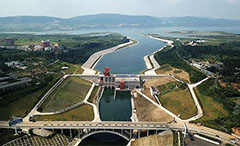System to protect water extended across country
2019-01-19
China Daily
China has extended its river and lake chief system across the country as scheduled and the system has played a significant role in helping improve water quality in many regions, said China’s top water resources watchdog.
As of the end of 2018, there had been almost 1.3 million river and lake chiefs across the country. Among them, 60 are Party chiefs or governors of provincial regions, said the Ministry of Water Resources in a statement, responding to questions from China Daily.
While more than 300,000 river chiefs from provincial to township level have been in position across the country, some areas have extended the system even further by appointing 930,000 of the chiefs at village level, which is not required by the central authorities.
About 57,000 lake chiefs have also come into duties, according to the ministry.
China’s central authorities released a document in November 2016 ordering the river chief system —which requires senior officials at every level of government to take full responsibility for protecting water bodies in their regions —to be established nationwide by the end of 2018. Another document published in late 2017 demanded the appointment chiefs for the country’s lakes before the same deadline.
The chief system is one of the latest methods China is using to promote the country’s ecological civilization. That effort was mandated in 2013 by the Third Plenary Session of the 18th Central Committee of the Communist Party of China, which is led by Xi Jinping as general secretary.
The session vowed to set up a complete institutional system for environmental protection and reform the related governance system.
“Establishing the chief system nationwide is a major institutional innovation in China to help address its complicated water problems. It’s a significant measure to guarantee the country’s water safety,” E Jingping, minister of water resources, was quote by People’s Daily in a report on Jan 16.
Under the system, the protection work of water bodies is linked to the performance evaluations of top officials.
Many local water resource officials applauded the system as an effective measure to combat water pollution as the chiefs, who are senior officials, could mobilize resources from various departments to contribute to water protection.
The ministry said great achievements have been gained in water body protection thanks to the chief system.
Jiangxi province, for example, has seen a great improvement in its water quality after it established the system in 2015.
Only 81 percent of surface water in the province was at or above Grade III, the third highest in the country’s five-tier water quality system, in 2015. The number had increased to 88.5 percent in 2017.
It also said the province has effectively curbed illegal construction, sand excavation and trash dumping along the Yangtze River, China’s longest.
In Zhejiang province, the first to pilot the system in 2003, about 6,500 kilometers of river sections have got rid of trash dumping and another 5,100 kilometers of sections that used to contain discolored and foul-smelling water have been cleaned up.
There has been almost no water with quality below Grade V, the lowest of the water quality system, in the whole province, the ministry said.
It said it will set up a profile and a tailor-made treatment plan for each of the country’s rivers and lakes.
“The ministry will also guide local authorities to resort to technologies, including satellite remote sensing, unmanned aerial vehicles, video surveillance system and big data, to carry out dynamic monitoring of water bodies so that they will be able to follow and compare processes in water body treatment,” it said.
It also said it will conduct both open and secret inspections to learn about how chiefs fulfill their duties and the real situation in water remediation.


